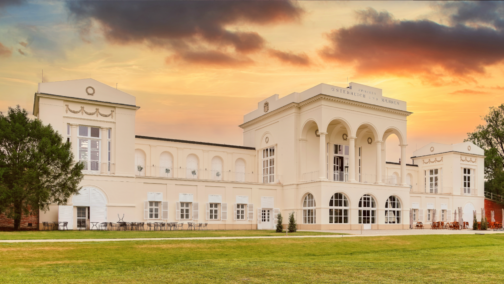
The charming Classicist chateau is considered the largest border landmark in the world. Prince Jan I. Josef of Liechtenstein had it built for relaxation and rest as the last in a series of structures to delight the eye and body during rides around the area. The chateau served as the summer residence of the Liechtensteins. The original design by architect Josef Engel – two castles connected by a bridge – was vetoed by the prince, so a chateau was created consisting of three pavilions connected by ground-level wings. And just as the bridge was to connect Lower Austria and Moravia, the Border Chateau stands precisely in the middle of this original provincial border, as evidenced by both the border stream flowing from the urn of a stone nymph lying behind the chateau and the inscription “Zwischen Oesterreich und Maehren” (Between Austria and Moravia).
The central pavilion has a protruding facade with three originally open, now glazed arcades. The roof of this facade serves as a loggia with four columns, which can be accessed from the decoratively painted hall on the first floor of the building. The end prism-shaped pavilions are adorned with large windows and inset Tuscan columns. The roof of the connecting communication wings serves as an observation terrace with a railing and is enclosed at the rear by a wall decorated with blind arcades. Due to the marshy substrate, the construction had to be placed on massive grids and many wooden piles.
Even this building was not spared from tumultuous historical events in the 20th century. In the 1930s, decisions were made regarding the construction of the Czechoslovak border defense system, and the Border Chateau became a military bunker. In 1945, the property was confiscated and served as an ornithological station. It underwent renovations only in 1995.
Kapacita sálu 40 míst. Objekt není bezbariérový ![]()
Parkování: u Chateau de Frontière
©LVMF